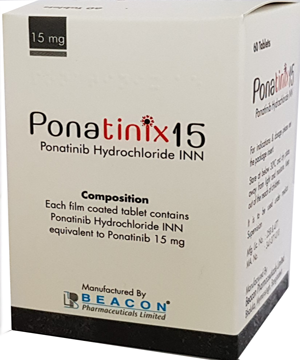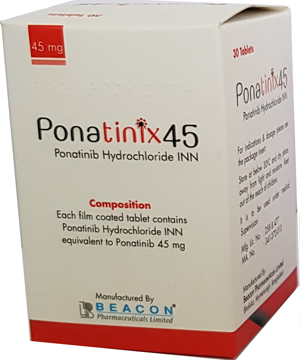Ponatinix 15 Tablet: Each commercial box contains 60 tablets in a HDPE pot Ponatinix 45 Tablet: Each commercial box contains 30 tablets in a HDPE pot.
DOSAGE AND ADMINISTRATION
Recommended Dosage
The optimal dose of Ponatinib has not been identified. In clinical trials, the starting dose of Ponatinib was 45 mg administered orally once daily. However, in the phase 2 trial, 68% of the patients required dose reductions to 30 mg or 15 mg once daily during the course of therapy.
Start dosing with 45 mg once daily. Consider reducing the dose of Ponatinib for patients with chronic phase (CP) CML and accelerated phase (AP) CML who have achieved a major cytogenetic response. Consider discontinuing Ponatinib if response has not occurred by months(90 days). Ponatinib may be taken with or without food.
WARNINGS AND PRECAUTIONS
Arterial Occlusion
Arterial occlusions, including fatal myocardial infarction, stroke, stenosis of large arterial vessels of the brain, severe peripheral vascular disease has occurred in at least 35% of Ponatinib-treated patients from the phase 1 and phase 2 trials. With a minimum of 48 months follow-up for ongoing patients (N=133) in the phase 2 trial, 33% (150/449) of Ponatinib treated patients experienced a cardiac vascular (21%), peripheral vascular (12%), or cerebrovascular (9%) arterial occlusive event; some patients experienced more than 1 type of arterial occlusive event.
Ponatinib can cause fatal and life-threatening arterial occlusion within 2 weeks of starting treatment, and at dose levels as low as 15 mg per day. Ponatinib can also cause recurrent or multi-site vascular occlusion. Patients have required revascularization procedures (coronary, cerebrovascular, and peripheral arterial).
Venous Thromboembolism
Venous thromboembolic events occurred in 6% (25/449) of Ponatinib-treated patients, including deep venous thrombosis (10 patients), pulmonary embolism (7 patients), superficial thrombophlebitis (3 patients), and retinal vein thrombosis (2 patients) with vision loss.
In the phase 2 trial, the incidence of venous thromboembolism was 9% (3/32) in patients with Ph+ ALL, 10% (6/62) in patients with blast phase (BP) CML, 4% (3/85) in patients with AP-CML, and 5% (13/270) in patients with CP-CML. Consider dose modification or discontinuation of Ponatinib in patients who develop serious venous thromboembolism.
Heart Failure
Fatal or serious heart failure or left ventricular dysfunction occurred in 6% of Ponatinib-treated patients (N=29/449) in the phase 2 trial (48 months follow-up). Nine percent of patients (N=39) experienced any grade of heart failure or left ventricular dysfunction. The most frequently reported heart failure events were congestive cardiac failure and decreased ejection fraction (in 14 patients each; 3%).
Monitor patients for signs or symptoms consistent with heart failure and treat as clinically indicated, including interruption of Ponatinib. Consider discontinuation of Ponatinib in patients who develop serious heart failure?
Cardiac Arrhythmias
Arrhythmias occurred in 19% (86/449) of Ponatinib-treated patients, of which 7% (33/449) were grade 3 or greater. Arrhythmia of ventricular origin was reported in 3% (3/86) of all arrhythmias, with one case being grade 3 or greater. Symptomatic bradyarrhythmia’s that led to pacemaker implantation occurred in 1% (3/449) of Ponatinib-treated patients. Atrial fibrillation was the most common arrhythmia and occurred in 7% (31/449) of patients, approximately half of which were grade 3 or 4.
Other grade 3 or 4 arrhythmia events included syncope (9 patients; 2.0%), tachycardia and bradycardia (2 patients each 0.4%), and electrocardiogram QT prolonged, atrial flutter, supraventricular tachycardia, ventricular tachycardia, atrial tachycardia, atrioventricular block complete, cardio-respiratory arrest, loss of consciousness, and sinus node dysfunction (1 patient each 0.2%). For 27 patients, the event led to hospitalization. In patients with signs and symptoms suggestive of slow heart rate (fainting, dizziness) or rapid heart rate (chest pain, palpitations or dizziness), interrupt Ponatinib and evaluate.
PHARMACEUTICAL INFORMATION
Storage condition
Store at below 30oC and dry place, away from light and moisture. Keep out of the reach of children.
Presentation & Packaging
Ponatinix 15 Tablet: Each commercial box contains 60 tablets in a HDPE pot.
Ponatinix 45 Tablet: Each commercial box contains 30 tablets in a HDPE pot.
MANUFACTURER
Facilities
Beacon Pharmaceuticals Limited has the world class facilities to manufacture world class products. The state-of-the-art facilities of Beacon is designed & developed by the renowned European Consultant Company to meet the highest international regulatory standards like US-FDA, UK-MHRA, TGA-Australia.
The facility is located at Bhaluka, Mymensingh, 79 km North from Dhaka, Capital city of Bangladesh. The total area of the site is 60703 square meter (15 acres) with a built up area of 15000 square meter. The buildings are Ferroconcrete structure & equipped with all the Hi-Tech sophisticated production machineries.
Quality Policy
When you buy our products, you can be sure of their quality, safety and efficacy.
To this end, the Company has set up, implemented and continuously improves the pharmaceutical quality management system in compliance with the regulatory requirements in force and the worldwide standards.
The system is intended to provide and constantly maintain the proper quality level of products and compliance with the requirements of the current good practices.
Beacon At A Glance
CSR
When you buy our products, you can be sure of their quality, safety and efficacy.
To this end, the Company has set up, implemented and continuously improves the pharmaceutical quality management system in compliance with the regulatory requirements in force and the worldwide standards.
The system is intended to provide and constantly maintain the proper quality level of products and compliance with the requirements of the current good practices.


